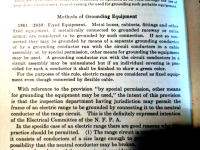Did someone ask a history question?
Let me dust off the collection...
Prior to the 1940 code grounding of a range with a grounded conductor was done by 'special permission' as implied by 2259(c).
The 1937 NEC handbook discusses this:
View attachment 2557884
Section 2560 Was first added to the 1947 Code it stated frames of electric ranges may be grounded to the grounded circuit conductor.
The 1953 NEC Expanded to electric dryers and added the requirement to 2560 that the conductor be at least 10AWG and the range be 120-240 three wire circuits.
The 1965 NEC 250-60 was the last code that allowed a frame of a single phase range or dryer to be grounded by the 'grounded circuit conductor' on the single condition that the wire was 10AWG or larger.
The 1968 NEC added that the grounded conductor of an SE cable could be used and the branch circuit had to originate at a service.
The 1996 code changes 250-60 to 'existing installations only' and the wording is much the same today.
The NEC consistently required conductors to be insulated the only exception I see is the standard one which allowed an equipment grounding conductor to be bare as is allowed today.
So to conclude the visit to the old books I think it would have been only by 'special permission' that the bare of a 10/2 could be used to ground a range or dryer legally.

